Ever wanted to start your own online course, but wondered how?
Foundr is here to give you the scoop on how to build your own online course. We speak from experience, having evolved from a humble magazine to a global education community, and we have learned a thing or two along the way of building successful online courses.
How did it begin? Well, as you probably know, we’re pretty big on Instagram.
Outside of the many articles that we’ve published on how to crush it on this social network, we know that there is a ton more to learn. That’s why we decided to create our own online course to teach others our exact steps on how to find success through Instagram.
This has proven to be a hit within our community, a fantastic product for us, and it has helped push our business to the next level.
So, to help our readers understand just how we did it, and how anyone can do the same, we’ve put together the following definitive guide on how to create an epic online course.
In the following article, we’ll walk you through the benefits of making an online course, the major steps involved in setting one up, and even a guide to helpful tools and resources that we’ve used ourselves.
READ MORE: 7 Legit Methods to Teaching Yourself Any Skill
Why Should I Create an Online Course?
First thing’s first: why should you even build an online course at all? As you’ll see below, it’s not rocket science, but it is quite a commitment.
For starters, it’s important to note some radical changes happening in education today. You may traditionally think of learning in the context of a huge lecture hall, chalkboards, or even kids programming like Sesame Street and Mister Rogers.
But education is increasingly all about online learning. In recent years, we’ve seen a massive surge of funding turning toward EdTech, with $59 million raised in the US alone for related startups like the Kahn Academy.
In fact, according to market research firm Global Industry Analysts, the online education industry will grow from $107 billion in 2015 to $370 billion in 2026.
Just look at these statistics by Statista from the beginning of 2020 estimating the global e-learning market size in 2026:
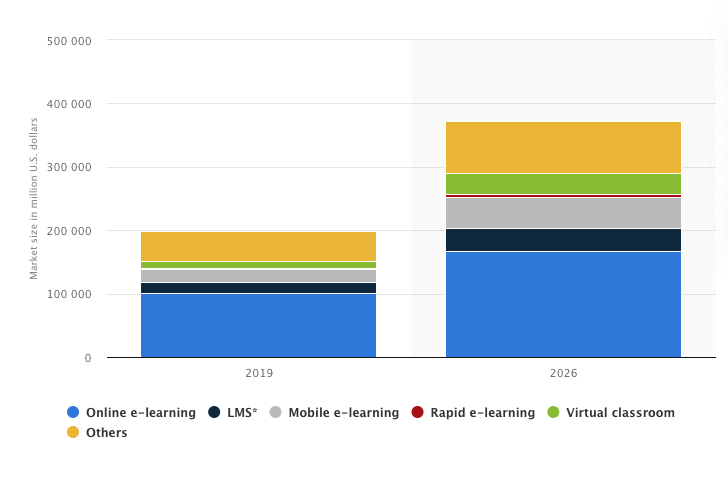
Bear in mind, this is pre-covid data.
That means that since this data was collected, online courses have overtaken traditional education in all aspects. People are seeking online courses as a viable option for other education streams. As universities and schools across the world close, people looking to upskill have the free time to do so, and as such online learning and courses suddenly became the norm.
Needless to say, online courses are where it’s at right now.
From simple online lectures to intensive boot camps, you’ll find courses that charge anywhere from a few hundred dollars to nearly $20,000, depending on the topic. And online courses allow you to pursue any specific topic you can imagine, without asking you to take gen ed courses you might not be interested in.
As a potential teacher, as long as you have specialized knowledge in something you know people want to learn about, you can start teaching with some pretty basic tools. So, there’s potential to make money through online education.
Here at Foundr, we’ve been very enthusiastic about this industry because democratizing education is at the core of our mission. Instagram Domination was just the first course we came up with, and since it’s continuing success we’ve launched course after course causing ripples across the entrepreneurial realm.
Below are just a few of our amazing courses, note that our Instagram Growth course has been recently updated, too. More on updating courses later.
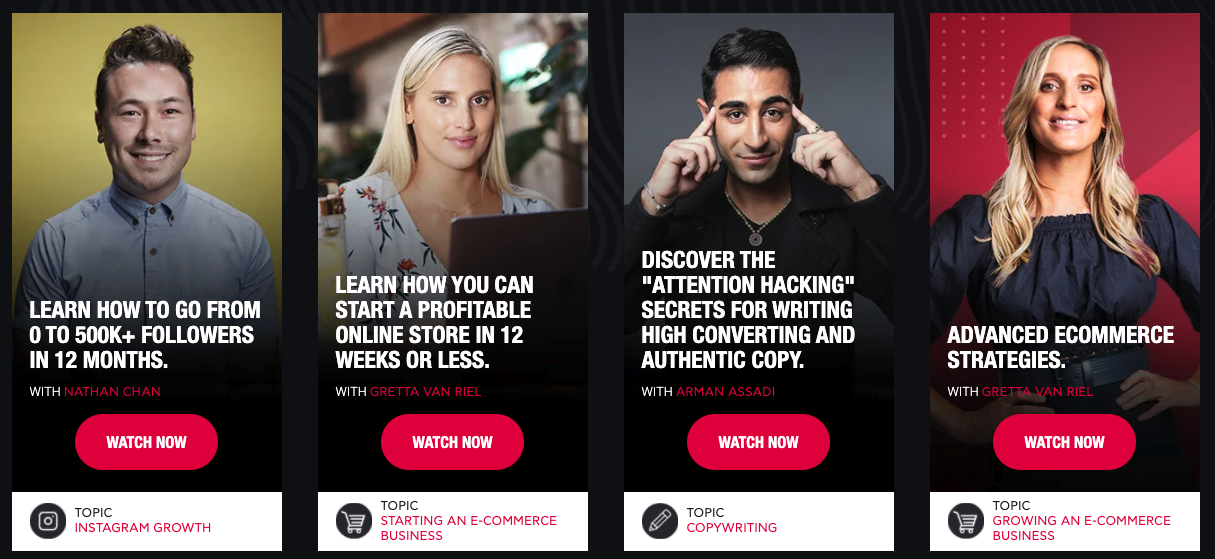
But we needed to figure out a lot of the details, especially how to scale up from Nathan hosting a webinar himself, to distributing pre-recorded lectures that could potentially serve our entire audience. Through a lot of experimentation, we got there.
Now, assuming you’re ready to get going with a course of your own, where do you begin?
How to Create An Online Course
Step 1: Define the Problem
Creating an online class is just like starting a startup. You must first find the right idea. But in order to do that, you must first define the problem.
In order to understand this realm of online courses better, I decided to reach out to Ankur Nagpal for his expertise. As the founder and CEO of Teachable, he’s facilitated more than 39,000 courses built with his software, so I figured he might know a thing or two about how to create an online course.
Throughout our conversation, one thing kept coming up: Identify the transformation.
What you have to remember is that knowledge is power. People want to use that power to transform themselves by learning something new. The goal of your online course is to help guide them through that transformation process.
The key to creating a successful online course is identifying exactly what outcome your audience is looking for.
Do they want to create their own app? Do they want to do magic tricks? Maybe they want to learn more about Java? Before you even begin building your online course you have to first figure out what results in your students are looking for.
As long as you’ve identified the transformation your students want to go through, you can practically create a course on anything. If you’re stuck for inspiration or want to scope the market, have a browse of the courses on Teachable and see if something jumps out:
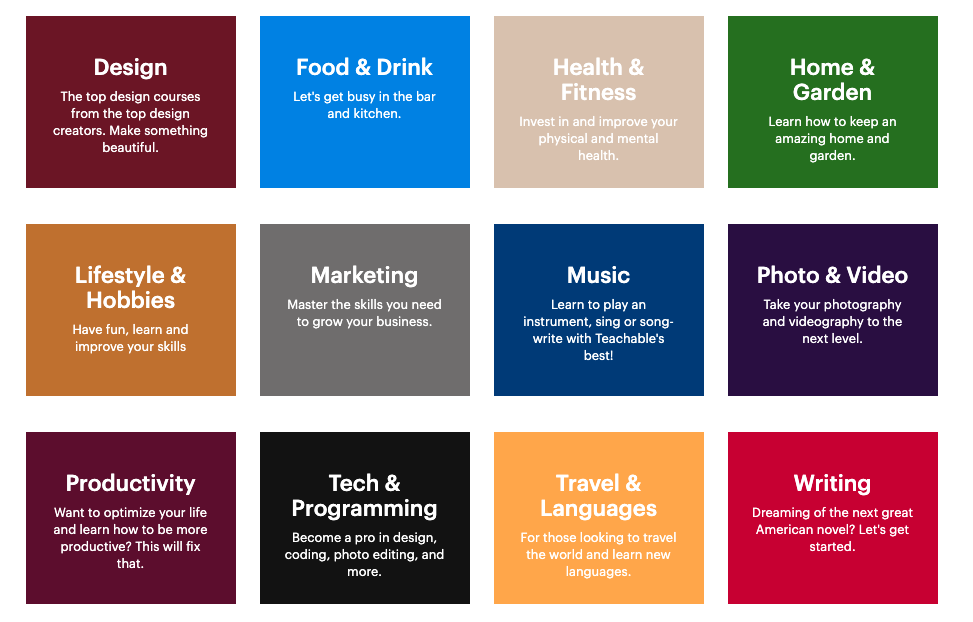
If you have an audience in place, then you have a good opportunity to see what’s in demand. If you have an email list or social media following you can fire out a quick survey asking them what they’d like to learn the most from you.
For example, if your brand sells cocktail shakers, then perhaps you can float the idea with your audience of launching a DIY cocktail making
One method is to visit sites like Quora and get involved with the community. See what people are asking in your niche. Are there any specific questions that people keep on asking? Is it something that you find yourself repeatedly answering?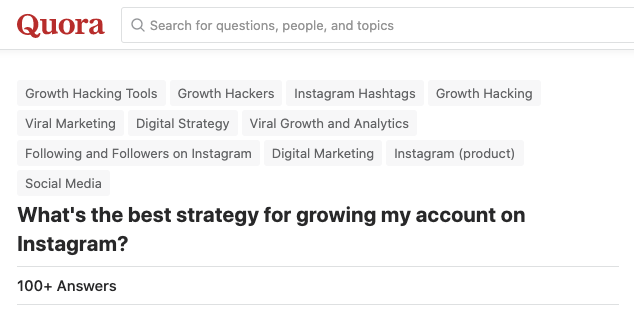
In the case of our Instagram Domination course, we found our problem fairly easily.
We had just started experimenting with Instagram and within two weeks we managed to grow our account to 10,000 new followers. So we decided to write a blog post about how we did it. We did a breakdown of our tactics and made sure to mention all the success we had found so far thanks to Instagram.
That post went viral.
It was shared over and over again and we started receiving dozens of emails every day asking us to go more in-depth. Every day there were people asking Nathan (our CEO) whether or not he would do one-on-one consultations with them; each wanted to replicate the same success we had achieved.
We found out that people wanted more than just followers. They wanted to know how to monetize their accounts, how to gain true followers, and how to use Instagram to build their brands. All things that we were already doing.
So early on, we definitely knew what the problem was and what outcome people were looking for.
Unable to go through so many one-on-one consultations, it was only natural that we would make an online course.
Step 2: Smoke Test
Now that you have an idea and you know what it is you want to teach, the next step is to validate it.
The truth is that while you might have a great idea, it doesn’t necessarily mean that it’ll translate into a great product, let alone a great online course. What you don’t want to be doing is spending hours and hours of precious time and energy on something that people ultimately don’t want.
The important distinction to make when it comes to validating any product is that you’re looking for paying customers. You can send out surveys and ask around, but the problem is that you’ll often encounter a lot of people who’ll say that they’d “probably be interested” in what you’re selling.
Just think about all of those unread books sitting on people’s desks, or annual gym passes that’ll never get used. People like talking about what they’d like to do, but chances are the majority of them won’t actually follow through.
So, how do you separate the wheat from the chaff?
One of the best ways to get validation for your course is to do a smoke test, meaning you start selling your course before it’s even completed. The easiest way to do a smoke test is to set up a simple landing page complete with pricing plans and a big prominent “buy now” button.
Now all you need to do is get this page in front of your audience, especially if you’re selling something that’s pretty niche.
Actively go and find out where your potential students are hanging out online and make a public post asking if they’ll sign up. If you have an email list, do an email blast advertising your course. You’ll have to do more than just put out a social media blast linking back to your page and hope for the best.
This whole process should take you a few days at most—a couple of hours to set up a landing page and maybe two or three days to get it out there. Once you’re done, all you need to do is check the data.
What you’re looking for is how many people clicked through and tried to purchase your product. If you’re looking at least 5% of visitors clicking through, or you’ve met your own target number, then you’ve effectively validated your idea.
When it came to our own online course on Instagram we did the exact same process. In fact, here’s the actual landing page we used when we did our own smoke test:
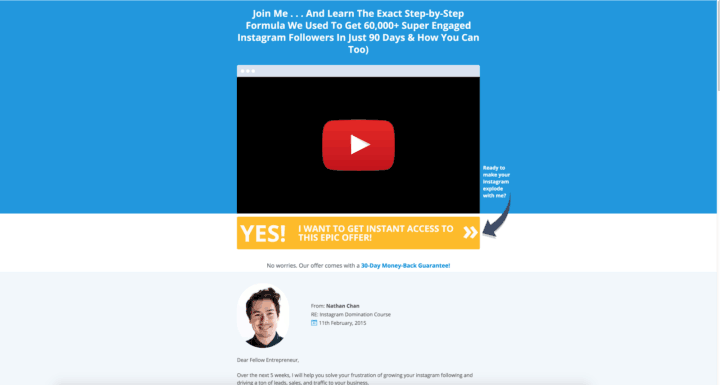
Vintage Foundr, right?
We did a blast through our email list asking if people would be interested in the course and just waited. We had hundreds of people respond saying that they’d be willing to pay for the course, and from there we set up our landing page and sent it out again. We found some amazing results and had a hundred people sign up for the course.
That was all the validation we needed to know that we had a great topic on our hands and that there were people out there hungry to learn what we had to offer.
READ MORE: 3 Ways to Create a Facebook Sales Funnel That Will Convert Customers on Autopilot
Step 3: Outline Your Course
This is possibly the trickiest part of creating an online course, especially if you’ve never had teaching experience before. Not everyone naturally makes a great teacher. You definitely don’t want to do this on the fly and try to make things up as you go. This is not one of those “just gotta stay one lesson ahead of the kid” moments.
If people are paying to learn from you, you need to step up your game. People can hunt down information on their own; what they’re paying you for is your ability to guide them through their transformation process.
The easiest way to set up a great course plan is to start repurposing any pre-existing content you have. Trying to create completely new content from scratch can be a huge waste of time and the effort involved might not be worth the payoff.
Take a look at any blog posts, articles, or ebooks you’ve written in the past—anything where you even mentioned the topic you’re about to teach.
Next thing is to take a look at all the other information that is already out there. Check to see what’s being said about your topic, do some in-depth research. But be careful of getting wrapped up in making this as complete and as perfect as possible. Remember that this is still a minimum viable product. It doesn’t need to be perfect, it just needs to work.
All you need to do is get the bare bones of your course down; you can develop it further once it’s up and running.
Now that you’ve gathered all the information, all you need to do is put it all together.
Break down your information into sections or modules. The completion of a module means that your student has successfully learned a new skill or aspect of your topic. It’s important that you keep your expectations reasonable so you make sure they constantly feel like they’re succeeding.

With your course structure, what you want to achieve is a natural progression where they go from beginner, to proficient, to expert. This is why you need to know the transformation in and out because you’re creating modules based upon the different stages your students will experience.
Now break those modules down into individual lessons. These don’t have to be exhaustive lessons that go on hours at a time; in fact, we recommend the shorter the better. Each lesson we have in our own modules is around three to four minutes, with the longest being around nine minutes.
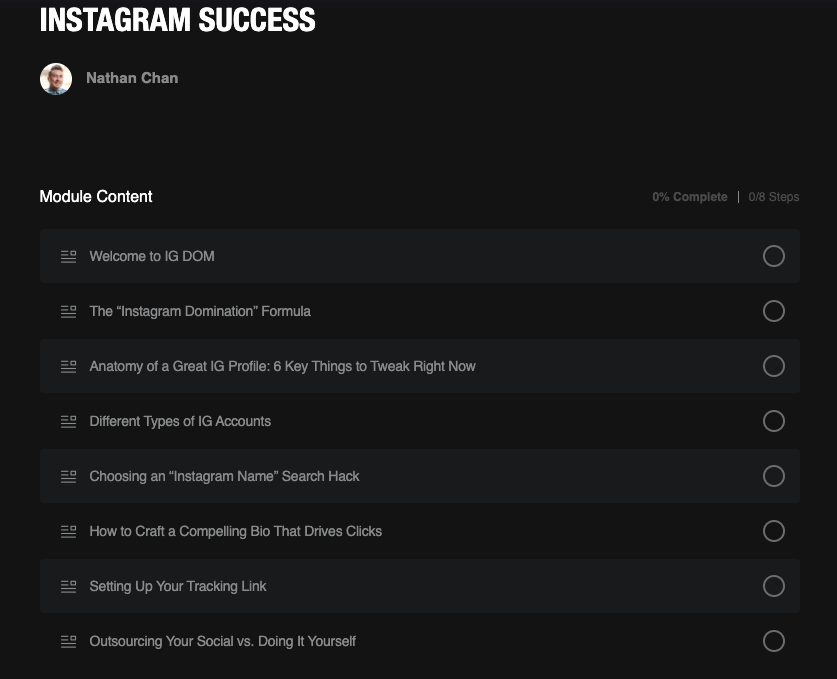
We closely followed the same model used by James Schramko of Super Fast Business, in which each lesson became an action item and followed the very simple outline of:
- What
- Why
- What if
- How
- Action
For example, when we were teaching a lesson on Share4Share, we broke it down into:
- Today we’re going to talk about how to do share-for-share.
- You need to learn this because it is one of the best hacks for rapidly growing your Instagram account.
- If you don’t apply this tactic, you’ll never achieve the results you want.
- Here are the different ways you can do S4S.
- Start doing S4S and approaching accounts once you hit 1,000-2,000 followers. S4S is a game-changer.
By following this format, we ensure that our students have simple instructions to follow and are constantly achieving tangible results.
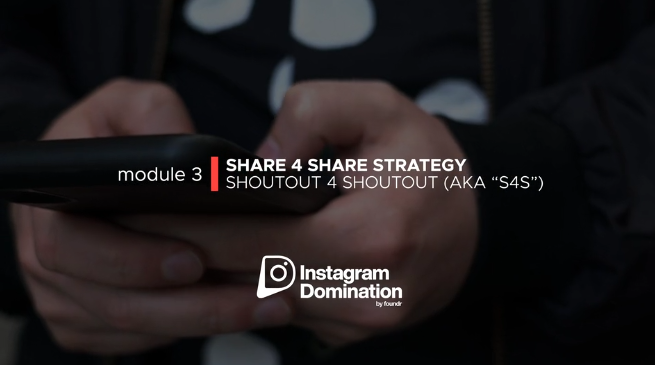
READ MORE: 10 Instagram Growth Hacks For More Engaged Followers (Without Running Ads)
Step 4: First Class of Students
When you’re developing any kind of product, whether it’s an online course, a teaching SaaS, or an entrepreneur magazine, you’re going to need to do a beta test.
A beta test is when you have your product and you’re just about ready to go to market. But first, you need to do a stress-test and actually let people other than yourself try it out. When you’re making an online course, your beta test is your first, and perhaps your most important, a batch of students.
They are your future case studies, your success stories, and the future ambassadors of your brand. Through them, you’ll be working out what does and doesn’t work with your course and they’ll give you invaluable feedback on how to move forward.
The number one thing we kept in mind while creating the first version of our online Instagram course was that it has to be as in-person as possible. We knew that it had to be as interactive as possible so we could gather feedback and find out what our students’ biggest struggles were during the course. What we didn’t want was a course where we’d be sending our worksheets and students would feel like they were talking to a faceless corporation.
Remember, it’s all about the transformation.
In order to have a good course, you must be dedicated to helping your students through their own transformation process. What you don’t want to be doing is just giving out information that they could get anywhere else for free.
The initial value of Instagram Domination was that our first set of students could get one-on-one interaction with someone who knew their stories, what they were trying to achieve, and could tailor the knowledge to them. When you’re teaching your course, you want to be as involved as possible.
All they consisted of was a very basic course plan Nathan would run through and a lengthy Q&A session afterward.

Now these Q&A sessions are extremely important because this is where you’ll be drilling deep and figuring out the pain points you’re experiencing. It is vitally important that you record all your initial sessions.
What you’ll be doing is going over these sessions later and turning any questions your students may have into potential lessons in the future. Go as in-depth as possible when you’re running these Q&As, because there’s bound to be a ton of gold you can get from them.
In fact, we even recommend doing in-person workshops, if it’s geographically possible. By doing this level of interactive work with your students, you improve your course, but you also cultivate some great case studies to cite as the course grows.
When you actually take the time to invest in helping your students transform and grow, what you’re effectively doing is helping the long-term growth of your own business. It’s because of all 100 members of our initial beta group that we’ve been able to grow Foundr to what it is today.
READ MORE: 30 Expert Tips on How to Get 10k More Followers on Instagram
Bonus: Stay for the Community
Something to keep in mind at all times is that the best value your students can ever get is from a community.
Although learning is somewhat of a solo activity, it is still a social process. You need other people to bounce ideas off of and, more importantly, you need peers who are able to go on the same journey as you.
As a teacher, it can be incredibly stressful if all the pressure is on you to have all the answers. By building a community around your course, what you’re doing is helping your students become self-sufficient and rely on the group more than they rely on you.
We created a private Facebook group just for our students. In order to encourage a sense of community, we also made sure to never answer questions one-on-one. We always made sure people voiced everything in the Facebook group.
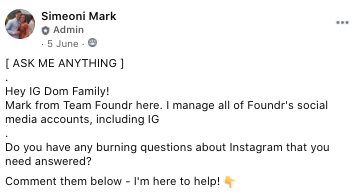
By answering all questions in a public setting this meant that everyone could benefit, and it also encouraged others to share their advice as well. We made sure to contribute and monitor that Facebook group every single day, something we still do right now.
A thriving community means different and diverse opinions, and more creative solutions you may not have thought about. Plus it helps that your students are more likely to be engaged with what you’re teaching simply through having someone else to talk to about it.
But just having a Facebook group where people can talk isn’t enough. Sometimes you’ll have to get in there and get the conversation started. It’s why we often do posts where we encourage others to share their wins, and goals with the group.
We always make the effort to welcome new members to the group. It helps to boost a sense of community and to reinforce our values.

We’ll even host friendly competitions within the group. Competitions are a great way to increase engagement and get your students to start applying themselves a little more.
Step 5: Validate, reiterate, and validate again
Since our first test of an online course about Instagram a little over a year ago, we’ve developed Instagram Domination 3.0, and you’d barely recognize how the course looks compared to when we first started.
But the thing about building an online course is that it’s rare that you’ll ever really “complete” it. There’s always something new to add and new to teach, especially if you’re teaching about a platform that you don’t have control over. Looking at you, fickle algorithms of Instagram.
So what you have to do is make sure that you keep on top of it and update it accordingly. One of the easiest ways you can become obsolete is if what you’re teaching is no longer relevant.
One thing that we knew very early on was that we would have to change our teaching method for the course. We were seeing a dramatic increase in the number of people who wanted to take our course, and at the time there was only Nathan teaching it! A pre-recorded course was the only way to make it fully scalable.
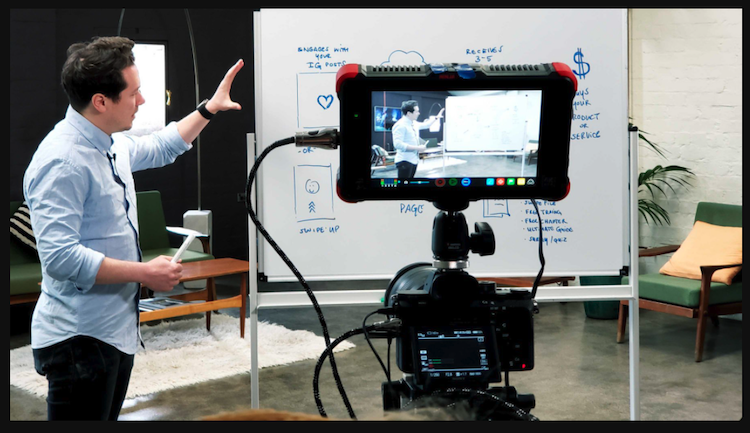
In order to service this growing number of students, we switched to the pre-recorded video format we have now. If you make this switch, Ankur Nagpal recommends sending out weekly surveys to your students in order to continuously stay informed about how your course is going.
In the following article, we’ll walk you through the benefits of making an online course, the major steps involved in setting one up, and even a guide to helpful tools and resources that we’ve used ourselves.
Creating loyal students
Before we finish off this article and thank you very much by the way for making it this far, let’s talk about the elephant in the room.
Yes, across the board, online courses have pretty dismal rates for course completion, with some posting numbers as low as 4%.
We’re very happy to report that Instagram Domination has a significantly higher completion rate at around 60%, with graduates seeing massive returns and huge success as a result. But finding the formula to reduce churn is never easy. We’ve managed to learn a few things about cultivating loyal students.
READ MORE: 7 Powerful Tactics to Get More Followers on Snapchat
Achieve results early
One thing that most instructors forget when creating an awesome online course is that online learning is almost entirely self-sufficient. It isn’t like school where you have a teacher or parent constantly telling you to do the work.
The key is to make sure your student stays motivated throughout the whole experience.
The best way to do this is to make sure that your students are achieving actual results. It doesn’t even matter if they’re small as long as your student can definitely look back and see some tangible results from your lesson. You constantly have to find ways for your students to immediately apply their knowledge and feel involved.
We include tools and resources as well as worksheets and action items at the end of every lesson:

If you have any advanced theory or concepts, save it for the end of the course. Resist the urge to do a massive information dump at the start because that’s a one-way ticket to boredom and dropouts.
READ MORE: FREE TRAINING: Explode Your Instagram Account With Our IG Hacks Masterclass
Adjust Your Course Price
This one might seem a bit confusing. After all, we live in an age when it’s all about giving away content for free. But what you’re going to find is that no matter how good your content is, making it free might get you more awareness but less engaged students.
We offer 99.9% free content across our website and .1% paid content, and we have found that those who put down money for the course were more likely to finish it successfully.
Data gathered by Teachable found that in paid courses, 36% of students on average completed the course. In free courses, only 9% on average would see it through to the end.
There is a direct correlation between how much you charge for your course and the engagement level of your students.
A quirk of human psychology is that when you make your content free or cheap, people are less likely to trust it and have low expectations for results. If you increase the price, people inherently feel that they’re getting more value.
Not to mention the fact that once people purchase your course they immediately feel compelled to see a return on their investment. No one wants to feel like they’re spending hundreds of dollars on something they’ll never use.
Drip-Feed the Course
This is something we actually don’t do for our own course, but it is something to keep in mind.
Drip-feeding is a marketing technique where instead of giving away all your content at once, you do instead “drip” your content out over a period of time. So instead of giving full access immediately, you release a new module every week.
Using this method means that your students are more likely to stay engaged because they now have a sunk-cost mentality and they want to see it through to the end.
The important thing to keep in mind when you’re drip-feeding a course is that you’re under pressure to constantly be providing something valuable. Every time you release a new piece of content you have to make sure that it’s as relevant and actionable as possible.
Otherwise what you’ll be doing is frustrating students who’ll feel like they’re not getting their money’s worth and that they’re not moving as fast as they’d like.
Ready To Make An Online Course?
Foundr couldn’t be prouder of the entrepreneurial community that we have grown thanks to our courses. In terms of growth, but also the level of personal connection, community, and education we can now deliver to our audience.
We only expect our courses to get better and better, and our community to continue to grow and flourish along with it.
This is how we did it, but you can certainly adjust or cherry-pick ideas for your own online course. The main thing we urge, however, is to really challenge yourself to better your students, and take full advantage of the interaction and community building aspects. That way, you’re bettering yourself along the way.
Got any questions for us on how to make an online course? Any requests for courses, for that matter? Let us know in the comments.
The post How to Create an Awesome Online Course Like Foundr appeared first on Foundr.
via https://AiUpNow.com October 16, 2020 at 03:16AM by Perrie Kapernaros, Khareem Sudlow,
